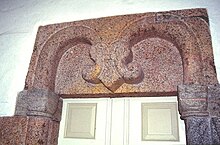Irish belt
The Irish Koppel ( Swedish Iriskt koppel ) is an ornamental form of the 11th century, which was passed down almost exclusively on Gotland grave boxes and Swedish rune stones . The serpent bodies of the representations, which are inscribed with runes , are bound by an ornament that received this name. The name suggests contact with Ireland or a simultaneous ornamentation on the island, but a characteristic paddock has not been found in Ireland to this day.
The differently shaped ornament is pretzel-shaped in the coupling part and also has similarities with the " French lily ". The question of whether the ornament has its origins in the West remains unanswered. The resemblance of Irish art to Nordic art during this period suggests Western connections, which can be seen more clearly in the Gotland silver hoards. The flow of minted silver from the British Isles to Scandinavia , which came about through systematic pillage by the Vikings and the so-called Danegelder , was supplemented by ornaments and other objects. A large amount of the silver ended up in Gotland for an unknown reason. In view of the coupling on one of the oldest rune stones in Södermanland (Vagnhärad), it is completely uncertain whether the decor shows a parallel direction of influence.
Sigmund Oehrl sees an element of the bondage iconography in the belt and considers it an apotropaic symbol. This is borne out by the positions above the portals of the churches of Gassum, Grensten, Hem, Kousted, Lem (see Weblink), Mørke and Tvede all (exclusively) in North Jutland, where the ornamentation, also known as båndsløjfe, replaces the usual apotropaic mask.
literature
- Erik Nylén & Jan Peter Lamm: Picture stones on Gotland . Wachholtz, Neumünster 1981, 1991 (2nd edition), ISBN 3-529-01823-6 , page 80
Individual evidence
- ↑ Sigmund Oehrl, depictions of four legs on Swedish rune stones: Studies on North Germanic animal and fettering iconography , supplementary volumes to the Reallexikon der Germanischen Altertumskunde 72. de Gruyter, Berlin / New York 2010.


